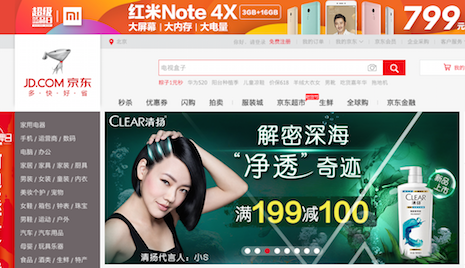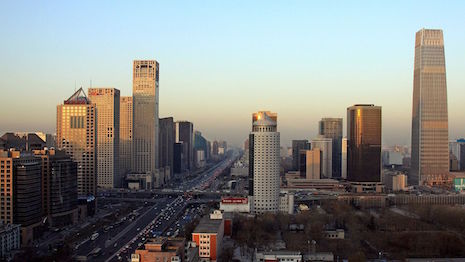NEW YORK – Luxury brands must understand that entering into the Chinese market requires more than just learning the language, it requires knowledge of an unfamiliar consumer ecosystem that is much different than what marketers are accustomed to in the West.
Speaking at the DLD NYC conference in New York May 12, L2’s head of APAC research spoke about the Chinese shopping landscape and the stark ways it differs from other countries. The biggest difference is in the digital platforms Chinese shoppers use to purchase products.
“It’s a completely different ecosystem," said Danielle Bailey, head of APAC research at L2. "Here in the United States we think of our brand site as the hub of our digital content.
"In China your brand site isn’t that," she said. "It's usually on etailer sites that that happens.”
Great firewall
The biggest difference in the Chinese consumer market to the rest of the world rests behind what is called "the great firewall." The Chinese government blocks many of the most popular sites that consumers use to search and shop in the rest of the world.
Chinese citizens do not have access to Google, YouTube, Facebook, Instagram or Amazon, along with a host of others.
Brands need to get used to using the popular platforms in China if they want to connect with Chinese consumers.
Instead of getting most of their brand interactions from social media, Chinese shoppers spend a lot of time on ecommerce platforms. The two most popular are Tmall and JD.

Tmall
Tmall does not hold much inventory, acting more as a platform for other retailers to sell their wares. What it does have is an entire ecosystem of services and types of content it hosts where users can share posts or watch television, for example, among a host of other activities.
JD is similar to Amazon in that it holds its own inventory and it is where a lot of customers buy the things they need.
The Chinese market leans very heavily on ecommerce, more so than in-store by some measurements. Additionally, the market is heavily mobile.
“The Chinese market is very mobile first. Almost three quarters of purchases are done on mobile, far past desktop," Ms. Bailey said. "Seventy-two percent of sales were mobile and 28 percent desktop in Q3 of 2016.
Ecommerce boom
The growth of China’s cities has supported strong investment into the luxury property sector worldwide. While the rest of the world’s properties have seen instability in price rates, investment into the luxury market has been strong this year (see story).
This means that luxury brands have even more incentive to market their products there, though they will have to navigate the potentially confusing new landscape.
A big part of Chinese marketing is on WeChat, which commands a huge audience.

JD
“WeChat is a sophisticated advertising platform," L2's Ms. Bailey said. "It was hard to advertise on it before but they made it easier to start.
"You can put ads out there, and if an influencer decides to use it, they can do that through the platform," she said. "Luxury brands really love this because it’s a closed environment and can kind of replicate print in a way."
Influencers also play a key role in Chinese marketing, particularly when it comes to luxury brands.
“Givenchy sold an exclusive version of a bag through WeChat and they sold out in minutes," Ms. Bailey said. "The same influencer, Mr. Bags, is now working with Burberry.
"These influencers can set up their own storefront through WeChat."
{"ct":"\/RV7AGVELhlFoC7KI8RtTLwN5NUuyUV6XoZFI94A16TBbCvtXQfH3H+h1IsHryRrkP7zigZXZc\/idr4El2pc1YTixIX06sI79RIPRs+z9VQR5GaG1QlDRIitSuioeb1NTdsBYhK243Uyw3FI5vqbT7i\/OHy0isE09b05fxSsTDhAQh4\/TZwKlxu6Rk3qHg3DfDD7j2j5k3Bkm+ZcdhJ76ZeMzPBqRlunC8wfQoQl+dENH8uoEVX7HgGiZY8GQz4A3tG15k8lzfq\/iKwcnQ1co4pmzSUgkb9bCgZ5xiIP5kEQQ3h6QX2tcPNVLE+AtY1IioloQEyg6vLYHmFgyqxfEisOyuQREDHqTNbd6CEcsRa82asn7GHwqrGD14wg2foIknzsZvutKT2+l0jV\/ZHRamdwa9\/wz2WIXbxOEjTY6YRW0t2pIDMo8uLxpl3H0trSTRH1qH2b7zwwsfRZeatZNAb6Fg5bguyA623upAW6t0fGco92MfOCeAondO16ptOlYuQxYAiOGfkkXAHYGNoKPQH8trJHOoPFAcBFLc6EZMlYh5S5vBlXE68qVMO8w1WGkZWw7UCgor1ZOeUilP++wN8T9bYkTsiZxNvN+Luzd2E9L+IxRsI6y9MQ45n81hV6W+udnAIQyOp0XeZ0S8CMIEA+gvxSkwALh070wMeTU9PiY0qYgAaiINTr4fbP8GuDEV2WkqdSH74rAEyfmS+iZaKxjm0Je+riSbaNuwxjGW1s3+K2Lg0PQ785kUelDEbDOurMSFe47zc4SrR1Y4xhSJtiW5ft\/tWY0uoaTwNjhRwzIVQNkv9bwjgzO5Y8sAaTcbiwJxwJL5RAA02ogUA8PuZREzky1EkBR9l8NFwEr+rQHXMNw81x1ZllcGdQOL9fLKgRWM7pCAFVP37\/B5LA+jnRzgjxLZonmZQCsoQWP3ALKsOxjK1IXZvEsXelMHiKzjK\/lroZtlVuqf9N4ZUKroJKSchb3c2gatB2PKBdO4rN1FG\/yOPaDcrUdiDp83XgWbvVjgJRTloxwP0XWAWjw7yN4zxBqc1dPy+nmluB6rkHTbUwAUkKJywl8c5RW98EiybET+6eDHdBr9nc2QPU7iOkhd2IrBam\/QqCc5FLSrMxj+GIbMKPqqpO+Rnw\/CUudaanXhXJmUGqvkWDqGkj8J8XJ9BcyN+pAABgp8uleO7PiyfHRRS0YwKDIHtUnOA1wwtkgXhD8oL5n4uxNply5u9h1oglzwaQLZPsbDNa9hgZIorCFytbwDfVPp5lmxF8rcC4P3dDiu4Yyq2yzTNyknEOcOmVVen+A5GQLKku7ltJvYSHKE9bwoY6uvG1OHxyYHU3FCWWuqhwDUUt0oBzAZ4Z72IsDEXlxQ4xjX0fmUCCHssh2DDIiOyDgwVNGm7nUWrX2eTyFseIPwHs3fzjhIdCG1WK\/Bd7n39DsRKRQJdoYrR20FEjqPbJIUAkllRaf\/8fnwgYMQ0gb2quEOg3GLr6j0J3YgJkiH66OMkl6oS+Efr8HuMEFIslDf+Bb+bBUoPmMfSvtrV1Ho2wtM9t1MtncRSrW9+rWbGB4V4jm09Z3Golanhqi8q4f9+gV4cAywR2qSUIWcjYIJ2UpvWxCW+roYFcYQfOoZTSnXtaDFEl4OOpUl+z75u0bw8sOh1k3J3ADWd2RklcK2aoC2G6vlB6sx2BP6GiFFYK6crPuF6B523nhQ5a6SwzHNxNIIFozxfGjxCLxqMXrsj36axwduarg5k\/RMUxvGqb5N7BXoRVbMxR4+D0v+9PBag\/JVYioOitsSXfbPgoiAJV86d2SQ7iUrJsjH5OJfPf+EsBdR2Ot9M51yio9VUxpJdl1DoxARKg36X6fBt0v\/LesaKUfrhUNJ+jXHTSWXyuWjYe\/Z1feVAxXHnYuzfoGpOuU9fY4f8F9yediu8oJBXKs2k91BBm7ks8BBCtH\/lIZtYK5M2eDzz4egaB8rDrdBO33NJ\/HMULpyPaUVRwBDUZTTQHjbhou3jpxWPfRf5ZOooPtuDjeFF5lv2K4wCOC6yXAehL7ofT0Ui7n5dZb8c\/IhsyqbSSiaApBT39eWfTuVBJii+QtDNwztZqV0CsHcsZk\/sJp24+lwejZe8hW8f41RyPX\/mZfO\/Vu\/h\/PHN0j8+d8uJWD6ZcEZYoH4EO8gcov6nC8ApI4tP4+UTML0RaRfx9zHpCtk\/BKhjeIwppnhtwG5+aZaQ4UnE7\/9jHiEECigC7pMHJd40KTjDrKCLVOc26YzM8FzfivRIugDgObDV\/hlI8idDdeYhL4WLpfWqx+CFOlYLP0w8iFJz\/00i8zwx+jXmqb52nkYlIWxofUEPb5Z06rg\/iUn2RhnQ93buVHxjBMZ+eUfSgkSkoXxV8+HReIIc2HH1V29NdJa4UQu78hXe62CKZSeO9JjR24MPUhw8cf58ZhkBQTI7EpXUZ8jZhBRy3vPKGfH6MriQ2u3RxC5knXk8VLy2UGpJeAh19wS8TnCc8HhEoQ19zliTtbjYLknYEvm9DFs1Ony6GWfjCbcJKaCBGR6zWabkG\/L\/t4ppCgLYYfEtbUpqE8SdrVTuFb9Aneilo6WNQAdei5zAPN92Jw9d04g0XiL9BxtT7OBi0zNNAD9RrcOyq8RljsyyGOpOhY8JOmcRu89PJdysxNpT\/Ne3BwvksYdf34KrAmxya8am2uVLRlJkH9gL3z7rgF5Hxa7wECUoanJUkYQ47RgODw8HNCc8XTBZYDEfMDmnRlfWbCFLLpqhTB8hQatrHKT\/41v9R4KqLPVhRocaN2H1\/IEBLdva+DXLPCAzscRzoFq\/melrB39hoq0WmALAboK\/r2aZQm3SuEI6W7GyndKBCpInJIuSXYJpBn4UEFQqL3\/MwXr0+xdHNm1Ni19aREvkuNFIWucgs2e9ag+zZ\/M7c1RjxlOOLx5mTbq4W15CLVdnsuvKYW2B6ZrC2oEfcGPgQdGHh37k1V771ePhDJQtHil0FT1TGOCo6AVkU4QTD1vkDKTvOqKi8ZUVFf1hH3THyTPuxdYhn\/jPQFuoGUiG\/TpQlpNQip9wfMmKl7QJJxDpV1gl723MMFMyl1angkPsKZVLdZsp4sqfjwHg3m1KBu3qRdk\/spv+rNeflq36Qn7mdkUbQ9oq\/1D4YfP0C7zLA+lKxi4soMQwhirCGuTewZRF8CLMGcMJ+z\/F2ciGP36EcutZiufjRbs63H8JdoAn+4eQqCwuUnU9lae+GNphX4WlaE4rptKqFNiKQ1mGFT6b2rIfl8nCH+bGNxYwp46h\/hT3WwSalT8Ol1vHEPoM+\/jAQRwn3wDKi+Zv\/xqOVJvS3lmslXjCTv+Br\/rhG0SmTg74tUzIQ4wJJNwauZvBdmzh9CCki20W+ocr51tQKb5jl1znCdfF8CqU6usf44Skve\/aZZ4JLffJLWfxpXWcCZUnxrEOgDlRVC8YhwJQqiW5wBEsY53CxGGfkGS7nsRSSAQdlLybEjiJt38GJSCjTtq1oPHzWPOAuEmBQ7hSjrh4HDbRs\/V0CVcfQGNb7ZWqSn1MMMh8nbSPBiqbp\/1V3CX5w\/t5mQ+ab50DmqDyQt5NQlPw+Uxd08\/FpvW0S1qPTClRY4fmYpt2EaVyvFixIa0cpZG0IM+kF5i783cEAgUldWKzpsWj2TblSUvKasicbP+gJerYxn9WQs3tDufPStqg0wAo7SoBpKKtcUs0fgy4A53Kfzu\/hOyQKoIXeHrwpDzSNSGix1j72WTs6gx3ut9QyjajTXDOHCdz+V0jXxRfwKBIcuJ8zHC\/XwuIE\/M7Eoa87hTI+ZeHf28t5Bhb\/ywVc6t\/88KzsEJMb9e0AQZ9Xu4AInVJDZfAbibRZTyjvggWnQleeTPCGQkgL4qWhoS+1PUcZX\/XOJ9xSc2KLZx4FMeZJTr0Tec9E6a4GyyfJYJ7PYQgufMSOPe+Yv4yOEAz3dS2JMsi9AzKYBKffNZcYERSUM9pgVOL\/\/rUSBaOJPZ9uRyVOXzz7WACOo6QBI6THlKvNLNeYWzP+qZWAl9CraHG\/dRSoElET59IdM\/fHPlnH7Fz66xgagW1ib43mSWy+1V87DEkRFnNilC2atyPOmd3zPzCe009+7k7jdxqpVacdhuBzw9QjKmW4dXZ5R5xDTVmty7pUpIfo4sp+8ybUFftluKjnPGb27kNVs24Vl5TR0LPeCQd401F8UueXIZtQKh8mH9aXM20NU0uuVCE2VZ9CKp0uk0zzhPb4iJ4EURjS4Wgt+VHdb\/x7c5SUVp8VcOTt6umSpkpaMyXCg6EhtEFceu\/Ra03iKrKuLRIARlRXNzVaD+W9HlFHC3wYq54MqqHxgrsAMt7snxyg1lHjWiFgVJ2zOVY5c14wewTj3GfRzjegAjzd6pTJbhJZSlECL1uxks2UmtnvpaSQfIITerFqmY\/JQ8oXXkn+MXz\/4bY4dL3hR7MbjxDqdtpDjKKd\/Mxydh+Av6UvLT4TaTfhrjpsuVloC4li2ZVG2coISga03829Oy\/SZJ0pVZaV2g8xbAG6Ynqg\/x8xfpbM8+2sMY8QWe8sDn7s\/TcGX6sAg1S\/d5EvbFsb8YtmSSvMZSGxWe97v2wqiyuUMGfx9s0e7K5Nb9wmJVYrG34s+VrLlmJgVe3ja\/m0vnfLour2MemXLL6vXDXcwjvq2li2nleq557iCy3AHdmUj8jRN5l9fVxz5w2GPkt+eYQGsoFIFTkcACuHNBCHVJ3NJakk\/mSzocki98XiXmmH\/Cwp4RRvVXma37HCdrkAlM4PpWUFZZu8prxItySE7wUdF2QMKMjIISLFKjSMGTcPw8a6eukVkxbRvJHOGi2UM1ggPZRgYPBfMJuGxnQDgpEgcoc8dWyGNOMAZ0ZFQBNrMgtGa6ddWF\/SKXiFNzNPLE\/o5x6ZRWZDDOXXW6H7wm813ttGejV\/hdkXwONbJTNmbwrMVdjjynmIYu0mTb9+\/UqKvilnl3Wven9qq8Ay7eMSKixYyI+pFLs45kVNWKKPXsuZVJrYICJL0PkKnuziaGIivOX\/AEwbDoH6OKrRRU38kVI\/nVdFqbv5lyUFjOLNnDGwGBbPRkOzFOt8QxDkolu7DItGIkTir1+KMRxzCBCkVVfAnuFTA2L1T4EOMCgKkevGwxtG\/A4sIdGFepwphOEthTemA4da7ETaUgJOMZNLOLLss+rf2MQMbsH6ZBmqX6+sgT+7NMVaqhv+tmL8tOxGwjvWIN0VmpORpqT1SIU5cQpAuxFt8PsL0AauTG3gvcEFYSxTIsmM4GIVGmDOalsyoIggrSNnvO1DRPU3WzhyipsUdoj\/7CUqNGBzb5tw27aY58yXbJsIRnMbrQFpTLBBSb7kY9d54\/4jUb3YpRu9iga3xQ+cAjLlAsWjT7GdGhjngQZ84KRmkbUcMy73oWz+V1t35RX3qLtJBUfH9lWHNquZYfALPG6ZEAm6OSUxeXC77n+MIFHdAiEClwoMWPzxUun+jhoW2ZpM8wlKgE9qpswOM8WT11uNPow4qZpLTc50hnzXZpiR2IXUe+oJk+LJWdHwYF4gz4NqiOg5WBIQNFo1ig+JFc52YxTt2Rpfo+gsXgtwl+FdFRIPIBquFSvfW2hVMAB6ntnY77iA5WQ0CvnsNCY5PfCmIFApkeAAJ9rXLAOB3aHLRxZwGhO50HnYqTRDVdL2LEQ9bwrsFR9VH7SMocgSuRYZvTJiWCrZ4PhOLmuDlx35QE0QoPUndxGiFzBJU314A4jsWlKcSg0+w\/poxAG\/Vcd4EyiFfazu16E99YPbzVCcOO3f9UQAQoFz6Oq9ffuNLp9\/dtwtese573CiZITUZPx1bj\/fzmDeDpIttO5D4RTiJvfJP7Ks6N8f4s15zg5y9tZVsg\/3w3EsT3xp+5pulS6mePnuO2JfStYjrrNMENXgn1djHG25bRveyP0mZHWMAHMPjLj7u2KBT29\/uwg5IWs7e5evDmY65WWiZEofhZMTuM6qdtlKadTVBAM5Gy95zotUcjthuxuERJRYS8g+rwrhFykGGCGT2V+DX7ZTjiCLlqKi4vE+bx1q1fmm+O37tQ5FI1\/RU5n7cYWRmcdNdZ7\/CBaf0JsibOOlvKXLH5g1Y6fNHPVDlugYTheyQUhbDtIO1Y9TJqUFdzpfMcdtTvoWkKX5gF2g57irZJzaTwswtQlvbyhOR3pUz+pF0O6Jdx88pVOm37dFecQw0l7phkHwDcftGtc3qxzuremf4jBfE6HMwvY9cjHZJmMET6zdQUoctqbh+B92iLdXBEkxvCf\/QRWQyUPo7ZhANOSDaQe4fIopNhYtcQB9GO3LWd\/dOsgj4kMyR0qoTAWT","iv":"83bc2da93a461e91caaa24fbd3d6d200","s":"82a94cc19781717a"}

 Due to government regulations, Chinese consumers use entirely different digital services than the western market
Due to government regulations, Chinese consumers use entirely different digital services than the western market